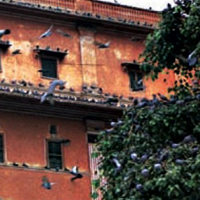The synanthropic status of wild rock doves (Columba livia) and their contribution to feral pigeon populations

Published: 7 October 2020
Abstract Views: 1147
PDF: 650
Publisher's note
All claims expressed in this article are solely those of the authors and do not necessarily represent those of their affiliated organizations, or those of the publisher, the editors and the reviewers. Any product that may be evaluated in this article or claim that may be made by its manufacturer is not guaranteed or endorsed by the publisher.
All claims expressed in this article are solely those of the authors and do not necessarily represent those of their affiliated organizations, or those of the publisher, the editors and the reviewers. Any product that may be evaluated in this article or claim that may be made by its manufacturer is not guaranteed or endorsed by the publisher.
Similar Articles
- Michelangelo Morganti, Birds facing climate change: a qualitative model for the adaptive potential of migratory behaviour , Rivista Italiana di Ornitologia: Vol. 85 No. 1 (2015)
- Luca Nelli, Habitat suitability models and carrying capacity estimations for rock ptarmigans in a protected area of the Italian Alps , Rivista Italiana di Ornitologia: Vol. 85 No. 1 (2015)
- Alessandro Canestrelli, Fulvio Fraticelli, Yellow-legged Gull Larus michahellis captures and drowns a Feral Pigeon Columba livia , Rivista Italiana di Ornitologia: Vol. 86 No. 1 (2016)
- Daniele Capello, Giovanni Boano, Importance of the arboreal-shrubby hedges as habitat for birds in an intensive farming area of the Turin-Cuneo plain (NW Italy). , Rivista Italiana di Ornitologia: Vol. 80 No. 1 (2010)
- Tommaso La Mantia, Bruno Massa, On the Rock Partridge in the painting “Saint Jerome in the study” by Antonello da Messina. , Rivista Italiana di Ornitologia: Vol. 80 No. 2 (2010)
- Andrea Amici, Fioravante Serrani, Settimio Adriani, Bruno Ronchi, Marco Bonanni, Riccardo Primi, A nesting area suitability model (MISN) to estimate the population parameters of Rock Partridge, Alectoris graeca orlandoi, in Rieti and Frosinone Provinces , Rivista Italiana di Ornitologia: Vol. 82 No. 1-2 (2012)
- Giovanni Boano, Fabio Perco, Marco Pavia, Natale Emilio Baldaccini, [Columba livia domestic breed, invasive entity also alien for Italy] , Rivista Italiana di Ornitologia: Vol. 88 No. 2 (2018)
- Massimo Brunelli, Fulvio Fraticelli, Check-list of the birds of Latium, updated to 2009. , Rivista Italiana di Ornitologia: Vol. 80 No. 1 (2010)
- Luca Baghino, Enrico Borgo, Marcello Bottero, Loris Galli, Rudy Valfiorito, Check-list of the birds of Liguria , Rivista Italiana di Ornitologia: Vol. 81 No. 1 (2011)
- Marco Masseti, Libyan birds. the remains of the italian ornithological collection in the Assaray Al-Hamra Museums of Tripoli, Libya , Rivista Italiana di Ornitologia: Vol. 81 No. 2 (2011)
You may also start an advanced similarity search for this article.


 https://doi.org/10.4081/rio.2020.479
https://doi.org/10.4081/rio.2020.479



